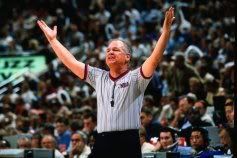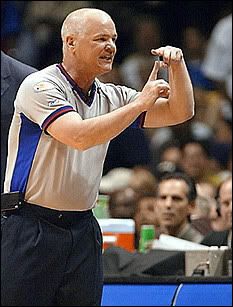As the international tournaments came to a close today (more on that tomorrow), I contemplated the transition of international players who enter the NBA not having attended college here in America. I recalled a post of mine from the Grizzlies Messageboard and will revisit it here.
We're all probably aware of the dreaded "rookie wall" that all players hit after entering the NBA from college. For most players this occurs somewhere near the middle of the season, typically around late January/early February. This is a result of players having to adapt from playing an average of 30-40 games a season in high school/college to an 82-game regular season in the NBA that is filled with travel and back-to-back games. So, we've come to recognize this as an eventuality, rather than something that only affects a percentage of in players (like the lesser-known "sophomore slump"). We're able to follow players in America from early on in their careers now, which means we usually have a reasonable level of familiarity on which to base expectations. However, with more and more players coming from international backgrounds, it has become increasingly difficult to determine not only how well their talent level and abilities will translate to the NBA game, but what expectations we should place on them. I believe that much of this is due to the fact that many fans are unaware of the length and type of seasons that are played overseas. An increased knowledge about this area should help us to determine what the transition curve should be for incoming international players, such as
Juan Carlos Navarro.
Many of the leagues are set up in a very similar nature to their soccer counterparts, which means that there are 2 or 3 different "leagues" or tournaments that occur throughout a season. Navarro's former team,
FC Barcelona, played 73 games last year, spread out over two leagues and a tournament (ACB, Euroleague and Spanish Cup). Their "season" lasted from October 1 through June 24, which is comparable to an NBA regular season and playoffs, albeit with approximately 20 fewer games played over that timeframe. Also, they only played one set of back-to-back games, which were the semifinal and final of the Spanish Cup. The more extensive schedule combined with the constant travel leads to fatigue for veteran players, so it is no surprise that it affects incoming rookies as greatly as it does.Here's a look at how some heralded international players (either then or now) have fared in their initial foray into the NBA.
Pau Gasol, age 21 (2001/02): 36.7 mpg, 17.6 ppg, 8.9 rpg, 2.7 apg, 2.1 bpg, .518 FG%, .709 FT%
Yao Ming, age 22 (2002/03): 29.0 mpg, 13.5 ppg, 8.2 rpg, 1.7 apg, 1.8 bpg, .498 FG%, .811 FT%
Peja Stojakovic, age 21 (1999/00): 21.4 mpg, 8.4 ppg, 3.0 rpg, 1.5 apg, 0.9 spg, .378 FG%, .320 3PT%, .851 FT%
Manu Ginobili, age 25 (2002/03): 20.7 mpg, 7.6 ppg, 2.3 rpg, 2.0 apg, 1.4 spg, .438 FG%, .345 3PT%, .737 FT%
Tony Parker, age 19 (2001/02): 29.4 mpg, 9.2 ppg, 2.6 rpg, 4.3 apg, 1.2 spg, .419 FG%, .323 3PT%, .675 FT%
Dirk Nowitzki, age 20 (1998/99): 20.4 mpg, 8.2 ppg, 3.4 rpg, 1.0 apg, .405 FG%, .206 3PT%, .773 FT%
Andres Nocioni, age 25 (2004/05): 23.3 mpg, 8.4 ppg, 4.8 rpg, 1.5 apg, .401 FG%, .258 3PT%, .766 FT%
Leandro Barbosa, age 21 (2003/04): 21.4 mpg, 7.9 ppg, 1.8 rpg, 2.4 apg, 1.3 spg, .447 FG%, .395 3PT%, .770 FT%
Jose Calderon, age 24 (2005/06): 23.2 mpg, 5.5 ppg, 2.2 rpg, 4.5 apg, .423 FG%, .163 3PT%, .848 FT%
Boris Diaw, age 21 (2003/04): 25.3 mpg, 4.5 ppg, 4.5 rpg, 2.4 apg, .447 FG%, .602 FT%
Jorge Garbajosa, age 29 (2006/07): 28.5 mpg, 8.5 ppg, 4.9 rpg, 1.9 apg, 1.2 spg, .420 FG%, .731 FT%
Toni Kukoc, age 25 (1993/94): 24.1 mpg, 10.9 ppg, 4.0 rpg, 3.4 apg, 1.1 spg, .431 FG%, .271 3PT%, .743 FT%
Based on the statistics above, it would seem that there is an adjustment period for practically every player upon entering the NBA, no matter how much talent they possess. It is worth noting that there was no discernible "rookie wall" that international players hit in comparison to their fellow players who attended college in the U.S. For the most part, many players simply exhibited a typical inconsistency from game to game that we expect out of rookies, but no dropoff after a certain amount of games. The conclusion I came to is that international players are more prepared for the long grind that is the NBA regular season than their collegiate counterparts. However, both sets of players require an adjustment to the talent level of the NBA. I'd love for
David Berri to tackle this subject in the future just to see what results he comes up with.





